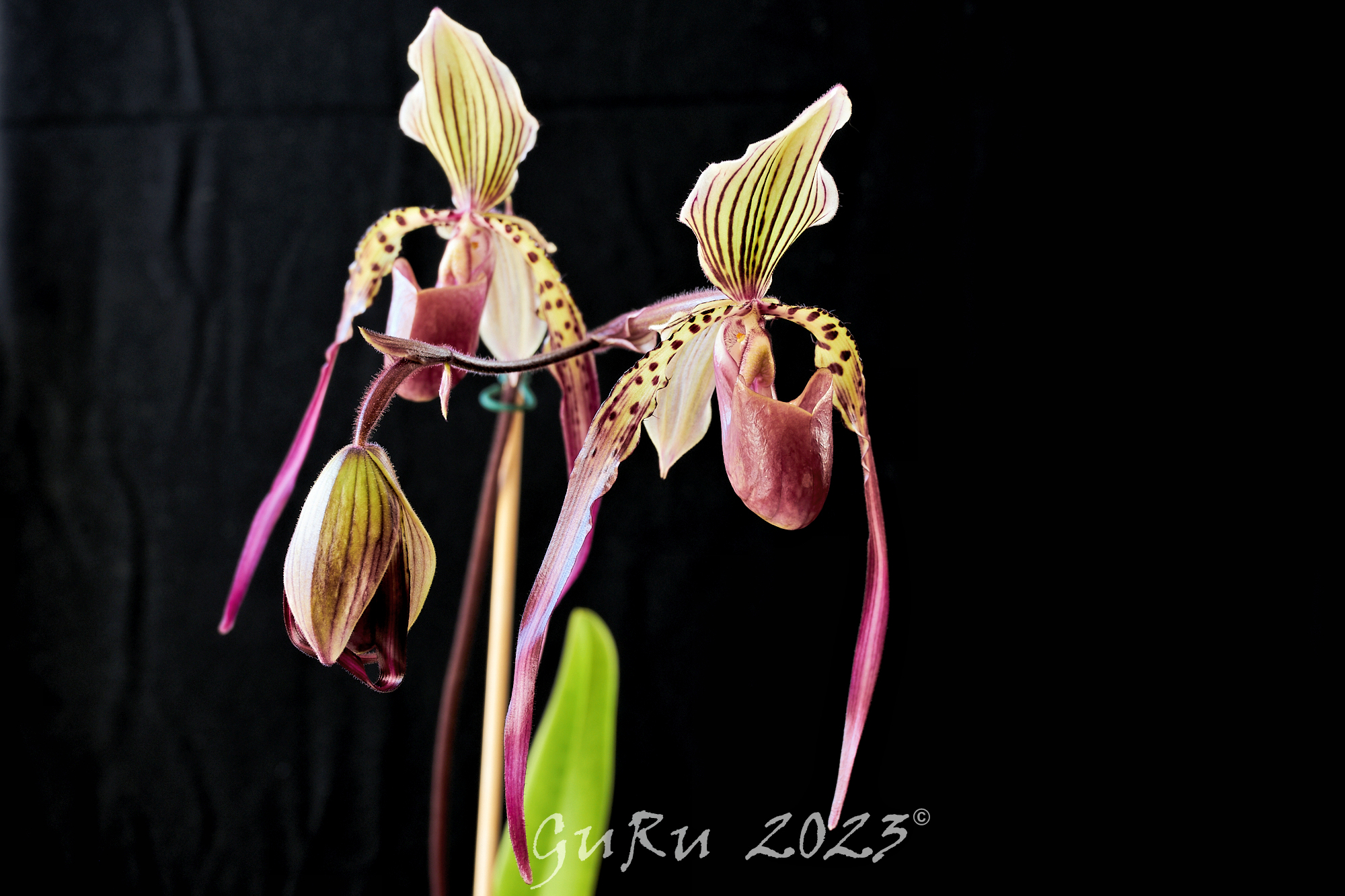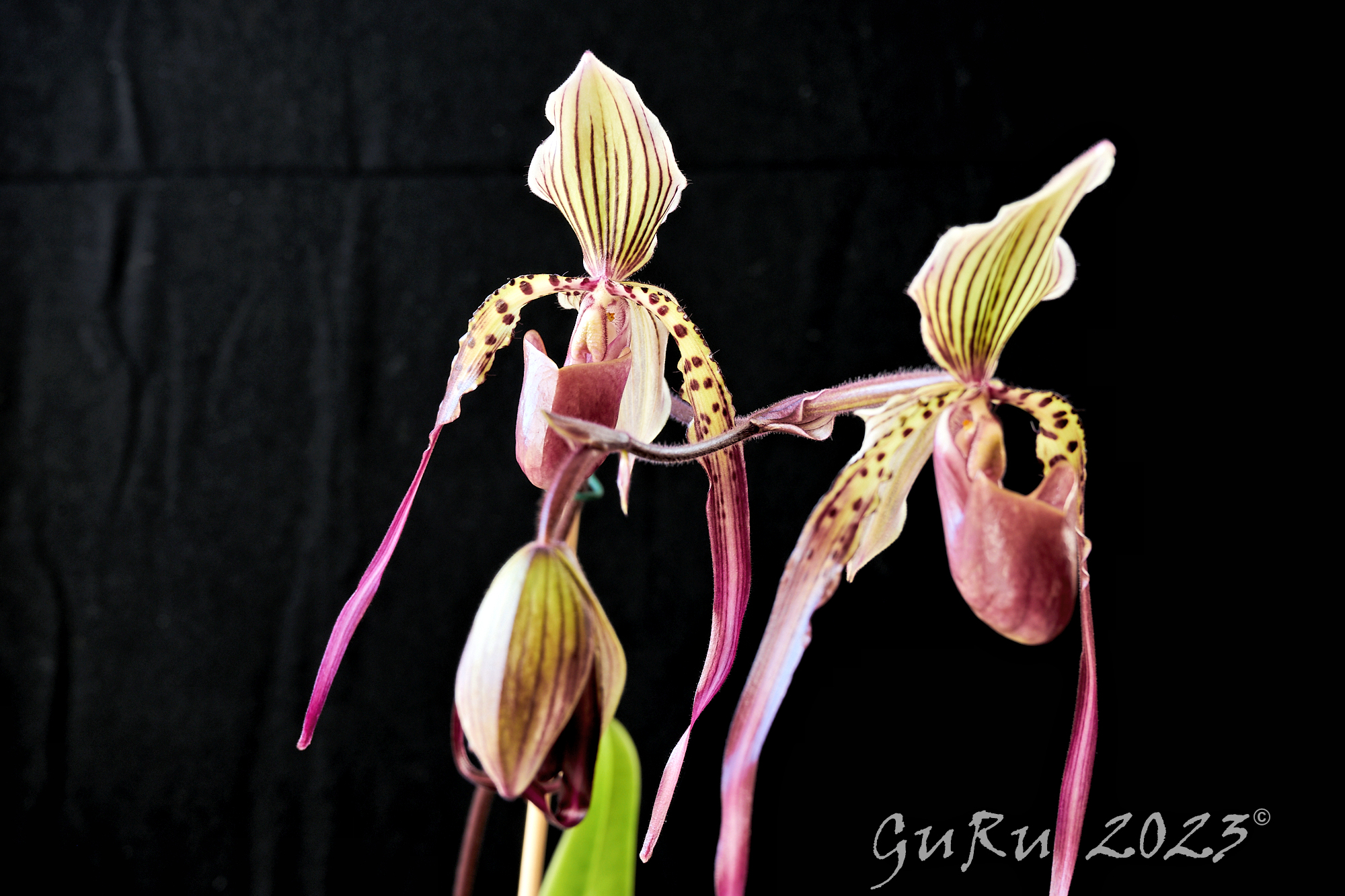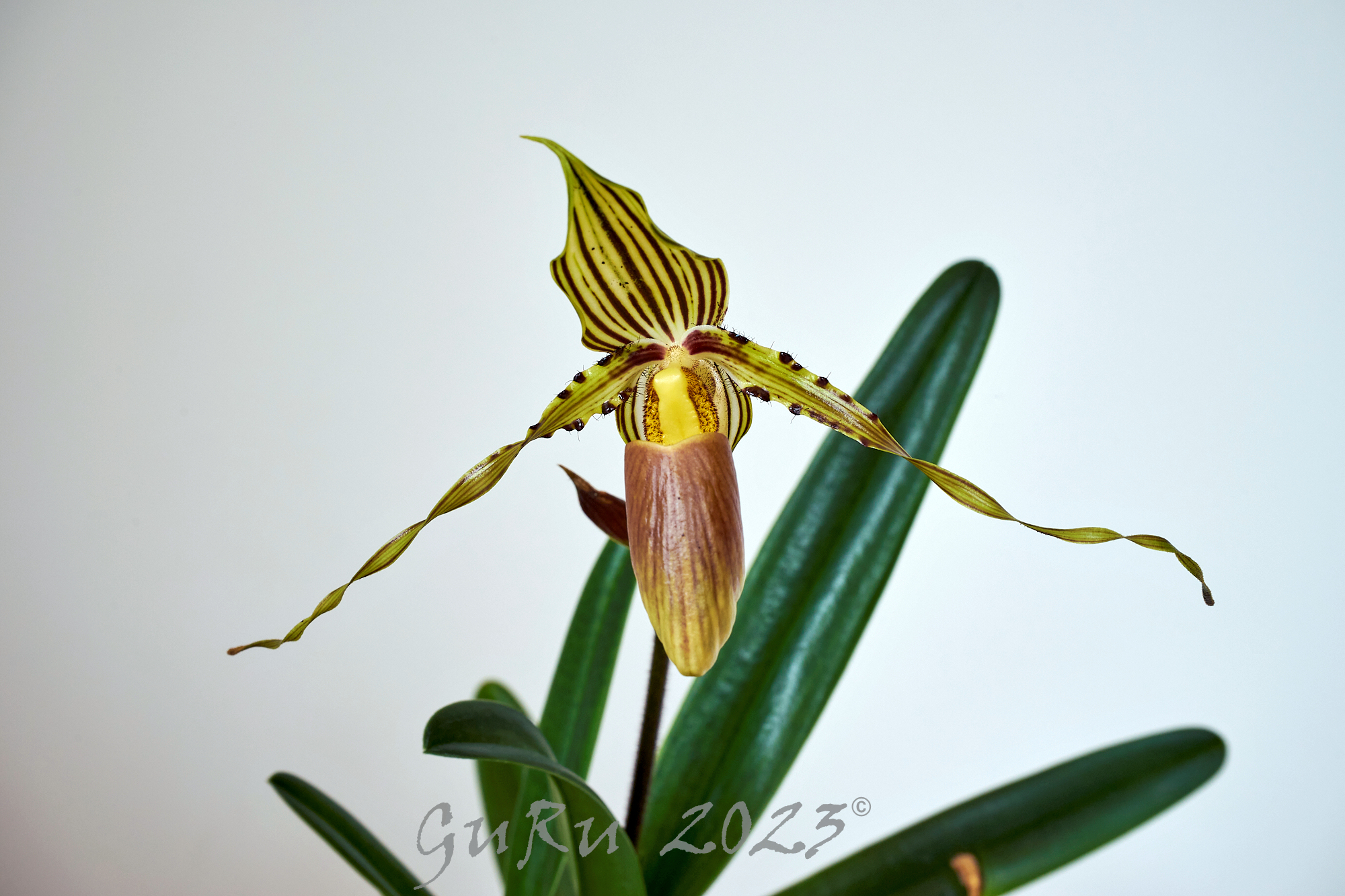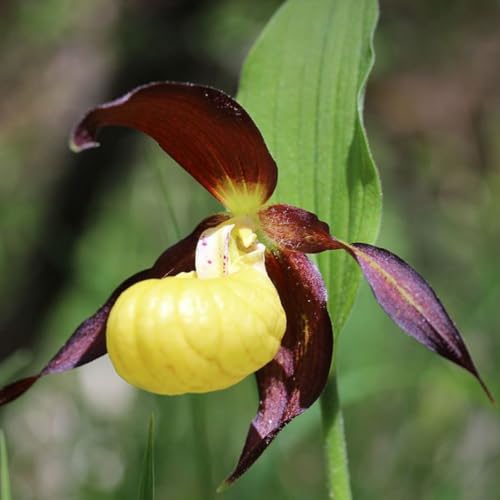Not haynaldianum… maybe Julius?
You are using an out of date browser. It may not display this or other websites correctly.
You should upgrade or use an alternative browser.
You should upgrade or use an alternative browser.
My Polyanthas in 2023
- Thread starter GuRu
- Start date

Help Support Slippertalk Orchid Forum:
This site may earn a commission from merchant affiliate
links, including eBay, Amazon, and others.
Michael Bonda
Well-Known Member
My guess would be Paph Lebaudyanum (haynaldianum x philippinense).Since last Friday I've been back home and meanwhile the buds in the photo of posting #2 are in flower. Yesterday with sunny wether I found time to take photos of these flowers. It's clearly one more mislabeled plant because I bought it as Paph. haynaldianum dark and ....yes the flowers are dark, tha's true, but obviously it. isn't Paph. haynaldianum but with high probability a hybrid with haynaldianum.
It would be nice if anybody could make a suggestion because I'm not really familiar with such hybrids.


Some pics of this hybrid look identical to yours, some photo examples do not have such long dark petals. Yours is exceptional !
Michael Bonda
Well-Known Member
tnyr5
Well-Known Member
Houghtoniae is my guess.
- Joined
- Nov 13, 2022
- Messages
- 287
- Reaction score
- 244
My first thought was also Julius as DrLeslie proposed, but the petals on Julius are usually more horizontal, but it`s possible. But Lebaudyanum is probably correct. Houghtoniae does not have so much red color on the petals at least that I know of. Both flowers are beautiful. No wonder the MK is called Long Hair and the second has also lovely colors. The red on the lower half of the petals is The whole flower is beautiful.
The whole flower is beautiful.
Thanks Michael and Annica, yes I think P. Lebaudianum matches the best.My guess would be Paph Lebaudyanum (haynaldianum x philippinense).
Some pics of this hybrid look identical to yours, some photo examples do not have such long dark petals. Yours is exceptional !
My first thought was also Julius as DrLeslie proposed, but the petals on Julius are usually more horizontal, but it`s possible. But Lebaudyanum is probably correct. Houghtoniae does not have so much red color on the petals at least that I know of. Both flowers are beautiful. ................

$31.33 ($3.13 / Fl Oz)
Vitabath Orchid Intrigue Everyday Skincare Set Moisturizing Shower Gel Wash, Reviving Lotion & Exfoliating Body Scrubber Pouf - Alluring Foam Cleanser & Dry Skin Hydration for Women & Men
Class01 USA (we record serial numbers)

$22.15
$44.00
Understanding Orchids: An Uncomplicated Guide to Growing the World's Most Exotic Plants
Amazon.com

$29.99 ($6.00 / Count)
5 Small Lady Slipper Orchids, Pink Orchids Plants Live Lady Slipper, Ornament Orchids Plant Root, No Leaf
KIM MARIE SMITH

$9.95 ($14.63 / Fl Oz)
Eternal Essence Oils 2 Pack 10ml Premium Fragrance Oil - Enchanted Orchid & Water Lily - for Candle, Soap Making, Aromatherapy, Diffusers, Home Care, & Humidifiers
eternal essence oils

$16.50 ($1.65 / Count)
JMSolution Active Orchid Moisture-Korean facial Skin Care Mask- Hydrating-Orchid extract-Hydrating Moisture -10 sheets for dry skin
MABLEST LLC

$24.98 ($24.98 / Fl Oz)
SeoulCeuticals Chebula Active Serum for Face - Korean Skin Care Anti Aging Natural K Beauty Skincare With Hyaluronic Acid + Spotted Orchid for Healthy, Youthful Glowing Skin 1oz
Digital Beauty Group

$58.99 ($5.90 / Count)
10 Small Lady Slipper Orchids, Pink Orchids Plants Live Lady Slipper, Ornament Orchids Plant Root, No Leaf
KIM MARIE SMITH

$29.99 ($15.00 / Count)
2 Pink Lady Slipper Orchid Plant Live Bud Roots, Live Orchid Plants Bud for Planting, Rare Orchids Plant
RACHEAL LEE BARRETT

$40.09 ($40.09 / Count)
$45.98 ($45.98 / Count)
hypehouse Allen + roth 8 in. Orchid Pot with Saucer White
Low Price Home Goods

$29.00 ($14.50 / Fl Oz)
CoQ10 & Stem Cell Rejuvenation Cream - Fight Oxidative Stress, Reduce Wrinkles, Promote Youthful Skin. Goji Berry & Orchid Extracts. 2 oz.
Advanced Skincare Shop

$30.49 ($30.49 / Count)
$32.99 ($32.99 / Count)
Body & Skin Care Set, Spa Kit, Self-care Relaxation Gifts, Skin Care Collection with Essential Oils, Spa Gift Basket, Orchid Jasmine Bath and Body Gift Set Pampering, Birthday Home Spa Gifts
hailida
- Joined
- Dec 14, 2020
- Messages
- 63
- Reaction score
- 75
I honestly think the name is correct Paph Leybaudyanum
After a long time of care now my Paph. praestans is flowering for the very first time. Unfortunately one of both buds withered some time ago for reasons I don't know ... but the other one bloomed out.
The praestans/gardineri/glanduliferum/wilhelminae complex has been discussed controversely between taxonomists. KEW Science follows lumpers who accept only two species ... Paph. glanduliferum and Paph. wilhelminae. Paph. praestans and Paph. gardineri are synonyms of P. glanduliferum. The splitters distinguish by the colouration of the petals and the shape of the staminode 4 species and 2 or 3 varieties of Paph. praestans.

The praestans/gardineri/glanduliferum/wilhelminae complex has been discussed controversely between taxonomists. KEW Science follows lumpers who accept only two species ... Paph. glanduliferum and Paph. wilhelminae. Paph. praestans and Paph. gardineri are synonyms of P. glanduliferum. The splitters distinguish by the colouration of the petals and the shape of the staminode 4 species and 2 or 3 varieties of Paph. praestans.

- Joined
- Dec 14, 2020
- Messages
- 63
- Reaction score
- 75
Paph LeybaudyanumPic for reference :
View attachment 38366
Ah, for once I find myself in complete accordance with KEW!KEW Science follows lumpers who accept only two species ... Paph. glanduliferum and Paph. wilhelminae. Paph. praestans and Paph. gardineri are synonyms of P. glanduliferum.

Jens, I'm not really. Let me explain why. Before I wrote my posting above I made a short inquest of flower photos and the differences which splitters mention.Ah, for once I find myself in complete accordance with KEW!
In my eyes there are significant differences in colouration and the staminode (shape and hair) between some of these 'individuals' which would allow to describe if not species in their own right but at least varieties.
Last edited:
I'll stick to my position, Rudolf, no matter what logic arguments, I'm presented with...just for once to taste how it feels not to be in the echo chamber with you!Jens, I'm not really. Let me explain why. Before I wrote my posting above I made a short inquest of flower photos and the differences which splitters mention.
In my eyes there are significant differences in colouration and the staminode (shape and hairs) between some of these 'individials' which would allow to describe if not species in their own right but at least varieties.
Last edited:
emydura
Well-Known Member
Nice one Rudolf. My praestans is almost open now as well and I am on the other side of the planet. 
Though, a wee bit closer to the habitat, than are we, up here!My praestans is almost open now as well and I am on the other side of the planet.
Similar threads
- Replies
- 5
- Views
- 2K

































